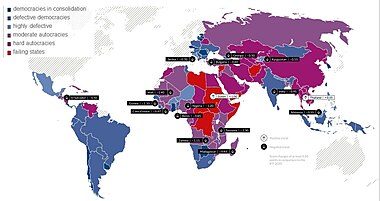Social:Democratic transition

A democratic transition describes a phase in a countries political system as a result of an ongoing change from an authoritarian regime to a democratic one [1][2][3] The process is known as democratisation, political changes moving in a democratic direction.[4] Democratization waves have been linked to sudden shifts in the distribution of power among the great powers, which created openings and incentives to introduce sweeping domestic reforms.[5][6] Although transitional regimes experience more civil unrest,[7][8] they may be considered stable in a transitional phase for decades at a time.[9][10][11] Since the end of the Cold War transitional regimes have become the most common form of government.[12][13] Scholarly analysis of the decorative nature of democratic institutions concludes that the opposite democratic backsliding (autocratization), a transition to authoritarianism is the most prevalent basis of modern hybrid regimes.[14][15][16]
Typology
Autocratization

Democratisation
Factors
Decolonization
Democratic globalization
Democracy promotion
Outcomes
Democratic consolidation
Stalled transition
Hybrid regime
Measurement

See also
- Energy transition
- Anti-authoritarianism
- Types of democracy
- Peaceful transition of power
- Radical politics
- Transition economy
- List of freedom indices
Notes
References
- ↑ Arugay, Aries A. (2021). "Democratic Transitions". The Palgrave Encyclopedia of Global Security Studies. Cham: Springer International Publishing. pp. 1–7. doi:10.1007/978-3-319-74336-3_190-1. ISBN 978-3-319-74336-3.
- ↑ Munck, G.L. (2001). "Democratic Transitions". International Encyclopedia of the Social & Behavioral Sciences. Elsevier. pp. 3425–3428. doi:10.1016/b0-08-043076-7/01135-9. ISBN 9780080430768.
- ↑ Cassani, Andrea; Tomini, Luca (2019). "Authoritarian resurgence: towards a unified analytical framework". Italian Political Science Review/Rivista Italiana di Scienza Politica (Cambridge University Press (CUP)) 49 (2): 115–120. doi:10.1017/ipo.2019.14. ISSN 0048-8402.
- ↑ Huntington, Samuel P. (2009). "How Countries Democratize". Political Science Quarterly ([The Academy of Political Science, Wiley]) 124 (1): 31–69. doi:10.1002/j.1538-165X.2009.tb00641.x. ISSN 0032-3195. http://www.jstor.org/stable/25655609. Retrieved 2023-04-17.
- ↑ Gunitsky, Seva (2014). "From Shocks to Waves: Hegemonic Transitions and Democratization in the Twentieth Century" (in en). International Organization 68 (3): 561–597. doi:10.1017/S0020818314000113. ISSN 0020-8183. https://www.cambridge.org/core/journals/international-organization/article/from-shocks-to-waves-hegemonic-transitions-and-democratization-in-the-twentieth-century/DC80A16B8DE79A7498B82B7F80FBE111.
- ↑ Gunitsky, Seva (2017). Aftershocks. ISBN 978-0-691-17233-0. https://press.princeton.edu/books/hardcover/9780691172330/aftershocks.
- ↑ Cook, Scott J; Savun, Burcu (2016). "New democracies and the risk of civil conflict". Journal of Peace Research (SAGE Publications) 53 (6): 745–757. doi:10.1177/0022343316660756. ISSN 0022-3433.
- ↑ Crocker, C.A.; Hampson, F.O.; Aall, P. (2016). Managing Conflict in a World Adrift. McGill-Queen's University Press. p. 156. ISBN 978-1-928096-48-1. https://books.google.com/books?id=hz1mDQAAQBAJ&pg=PA156. Retrieved 2023-04-23.
- ↑ Sönmez, Hakan (2020-09-30). "Democratic Backsliding or Stabilization?". Politikon: The IAPSS Journal of Political Science (International Association for Political Science Students) 46: 54–78. doi:10.22151/politikon.46.3. ISSN 2414-6633.
- ↑ Geddes, Barbara (1999). "What Do We Know About Democratization After Twenty Years?". Annual Review of Political Science (Annual Reviews) 2 (1): 115–144. doi:10.1146/annurev.polisci.2.1.115. ISSN 1094-2939.
- ↑ Törnberg, Anton (2018). "Combining transition studies and social movement theory: towards a new research agenda". Theory and Society (Springer Science and Business Media LLC) 47 (3): 381–408. doi:10.1007/s11186-018-9318-6. ISSN 0304-2421.
- ↑ Leonardo Morlino; Dirk Berg-Schlosser; Bertrand Badie (6 March 2017). Political Science: A Global Perspective. SAGE. pp. 112–. ISBN 978-1-5264-1303-1. OCLC 1124515503. https://books.google.com/books?id=qhcjDgAAQBAJ&pg=PA112.
- ↑ Brownlee, Jason (2009). "Portents of Pluralism: How Hybrid Regimes Affect Democratic Transitions". American Journal of Political Science ([Midwest Political Science Association, Wiley]) 53 (3): 515–532. doi:10.1111/j.1540-5907.2009.00384.x. ISSN 0092-5853. http://www.jstor.org/stable/25548135. Retrieved 2023-04-23.
- ↑ "Home - IDEA Global State of Democracy Report". https://www.idea.int/gsod/.
- ↑ Hameed, Dr. Muntasser Majeed (Jun 30, 2022). "Hybrid regimes: An Overview". IPRI Journal (Islamabad Policy Research Institute - IPRI) 22 (1): 1–24. doi:10.31945/iprij.220101. ISSN 1684-9787.
- ↑ Caballero-Anthony, M. (2009). Political Change, Democratic Transitions and Security in Southeast Asia. Routledge Security in Asia Pacific Series. Taylor & Francis. p. 7. ISBN 978-1-135-26840-4. https://books.google.com/books?id=VdONAgAAQBAJ&pg=PA7. Retrieved 2023-04-27.
- ↑ Nazifa Alizada, Rowan Cole, Lisa Gastaldi, Sandra Grahn, Sebastian Hellmeier, Palina Kolvani, Jean Lachapelle, Anna Lührmann, Seraphine F. Maerz, Shreeya Pillai, and Staffan I. Lindberg. 2021. Autocratization Turns Viral. Democracy Report 2021. University of Gothenburg: V-Dem Institute. https://www.v-dem.net/media/filer_public/74/8c/748c68ad-f224-4cd7-87f9-8794add5c60f/dr_2021_updated.pdf
- ↑ "Global Dashboard". https://bti-project.org/en/reports/global-dashboard?&cb=00000.
Further reading
- Coale, Ansley J. (1989). "Demographic Transition". Social Economics. London: Palgrave Macmillan UK. pp. 16–23. doi:10.1007/978-1-349-19806-1_4. ISBN 978-0-333-49529-2.
- Croissant, A.; Haynes, J. (2015). Twenty Years of Studying Democratization: Vol 1: Democratic Transition and Consolidation. Taylor & Francis. ISBN 978-1-317-61900-0. https://books.google.com/books?id=S1TLCQAAQBAJ&pg=PA19.
- Epstein, David L.; Bates, Robert; Goldstone, Jack; Kristensen, Ida; O'Halloran, Sharyn (2006). "Democratic Transitions". American Journal of Political Science ([Midwest Political Science Association, Wiley]) 50 (3): 551–569. doi:10.1111/j.1540-5907.2006.00201.x. ISSN 0092-5853. http://www.jstor.org/stable/3694234.
- Haggard, Stephan; Kaufman, Robert R. (2012). "Inequality and Regime Change: Democratic Transitions and the Stability of Democratic Rule". The American Political Science Review ([American Political Science Association, Cambridge University Press]) 106 (3): 495–516. doi:10.1017/S0003055412000287. ISSN 0003-0554. http://www.jstor.org/stable/23275430.
- Glaser, E. (2018). Anti-Politics: On the Demonization of Ideology, Authority and the State. Watkins Media. ISBN 978-1-912248-12-4. https://books.google.com/books?id=6uwxDwAAQBAJ.
- Huntington, S.P. (2012). The Third Wave: Democratization in the Late 20th Century. The Julian J. Rothbaum Distinguished Lecture Series. University of Oklahoma Press. ISBN 978-0-8061-8604-7. https://books.google.com/books?id=IMjyTFG04JYC&pg=PA1961.
- Kirk, Dudley (1996). "Demographic Transition Theory". Population Studies (Informa UK Limited) 50 (3): 361–387. doi:10.1080/0032472031000149536. ISSN 0032-4728. PMID 11618374.
- Stoner, K.; McFaul, M. (2013). Transitions to Democracy: A Comparative Perspective. Johns Hopkins University Press. ISBN 978-1-4214-0877-4. https://books.google.com/books?id=2BYNYiPmyMIC&pg=PP1.
External links
- Democracy data: how do researchers measure democracy? -Our World in Data
- Democratic Transition publications - Jstor
 |


